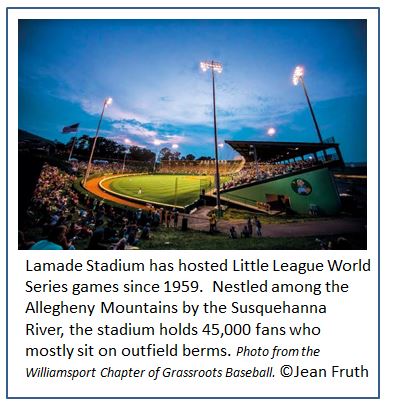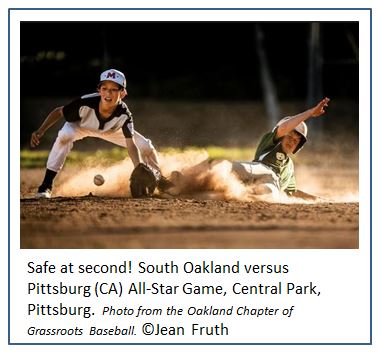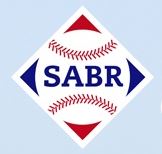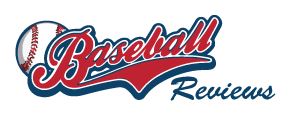 Grassroots Baseball
Grassroots Baseball
Where Legends Begin
Photographs by Jean Fruth
Sports Publishing, 2019
$60.00
Home sweet home. What makes baseball such an important part of our lives is that the game constantly pays tribute to where the heart is. After all, the only way to score runs is to leave home and then return.
From the foreword to Grassroots Baseball
If anyone can bring home the special passion that beats in the heart of our national pastime, it is photographer Jean Fruth – one of baseball’s preeminent photographers. In her book, Grassroots Baseball … Where Legends Begin, she does just that – presenting more than 250 heart-touching images from amateur fields and ball parks across the United States and from baseball-loving communities around the globe. You will be carried, visually, from the hot and dusty amateur ball fields of the Dominican Republic to the urban youth diamonds of New York City to the site of the Little League World Series in Williamsport to the colorful fields in Mexico upon which Caribbean Series is played – and plenty of places in between. BBRT Note: At the end of this post, you will find a BBRT interview with photograph Jean Fruth.
Jean Fruth’s photographs tell an uplifting story about baseball in its purest form – played for the love of the game. If you are a fan of the national pastime, you should have this book.
Baseball Roundtable
Fruth’s photos tell the story of growing up with baseball – in communities and circumstances ranging from places where home plate is a discarded license plate and baseball gloves are fashioned from old milk cartons to communities where youngsters can take advantage of batting cages and pitching machines. But the real story here may be what the youngsters who play on these diverse fields and in these widely varying conditions have in common. As you look at the faces of the young ballplayers in these photos, you will see grit, determination and concentration; elation and disappointment; quiet reflection and fierce competition; but mostly you will see wide-eyed joy – the joy of being on the ball field playing a game they all love.
The culture of Baseball is much more than what happens on the field. Shooting action is wonderful, but what makes baseball special and photo-worthy is how the sport shapes the culture in which it is played, and how local culture reflects the sport. The stories you can tell through pictures are often a direct reflection of the places in which the game is being played.
Jean Fruth
How good is Jean Fruth’s art? How well does her lens capture the heart and soul of the game? The list of those contributing the words that open and close the book and set the stage for each of its visual chapters tells that story.
Consider this lineup of contributors:
Introduction – Cal Ripken, Jr.
New York – Whitey Ford
Mexico – Fernando Valenzuela
Mobile, Alabama – Hank Aaron
Japan – Ichiro Suzuki
Cape Cod – Craig Biggio
Oakland – Rickey Henderson
Cuba – Tony Pérez
Williamsport, PA – Randy Johnson
Puerto Rico – Iván Rodríguez
Tampa, FL – Wade Boggs
Caribbean Series – Juan Marichal
Aberdeen, ML – Cap Ripken, Jr.
Curaçao – Hensley Meulens
Texas – Nolan Ryan
Afterward – Johnny Bench
And what stories they share! Not so much about their accomplishments on the major-league level, but how they (like most of those pictured in the book) grew up with the game. I won’t share too much, but here are a few examples from their stories.
- Whitey Ford’s earliest memories involved a broomstick bat, a pink rubber Spaldeen ball – and “fields” laid out on the streets of New York.
- Hank Aaron was discovered playing semi-pro softball.
- Ricky Henderson was born in the back of an Oldsmobile.
Randy Johnson – from Grassroots Baseball
“I remember my very first Little League practice. My parents were at work. My five brothers and sisters and I were raised to do things on our own, so I took myself to practice. There we so many people there that I just became confused and went home without playing. Fortunately, when I walked through the door my mom was there. She took me by the hand and made sure my life in baseball started that day … Thanks for getting me to practice, Mom.
- Valdimir Guerrero left school in the fifth grade to help take care of his brothers and sisters.Wade Boggs began playing Little League ball (age 5),hit bat was taller than he was. Oh yes, and he had 26 hits in his last 32 high school at bats.
- Juan Marichal, while playing amateur ball, was one put in jail for six days (along with his teammates), after losing a doubleheader.
Iván Rodríguez– from Grassroots Baseball
I always had a good arm, even as a little kid. When I was nine-years-old, I set my youth league record for strikeouts and no-hitters. At a regional tournament in La Llanura, I hit three batters. My dad pulled me from the game and told me from then on I was going to be a catcher.
By that enough about words – it’s Jean Fruth’s pictures that really tell the story. And, it’s a great and uplifting story about baseball in its purest form. Her photographs capture the colors and drama of the game – whether it’s played on dusty sandlots or in stadiums that hold 45,000; whether the game action unfolds under blue skies and bright sunshine or against the contrast of blue-black skies and bright ballpark lights; and whether that participants are youngsters in short and T-shirts or adolescents in full uniforms. But mostly, again, Fruth’s photographs capture the joy of the game, as it can only be expressed when you are playing for the love of the game. Again, if you are a fan of the game, you should have this book.
Maybe Ken Griffey, Jr. put it best, “Photography and baseball are both arts. Jean beautifully captures the youthfulness and charisma of the game of baseball.”
You can order Grassroots Baseball – Where Legends Begin (a signed copy for $55, including shipping and tax at www.grassrootsbaseball.com
Below is a brief biography and a Baseball Roundtable interview with Jean Fruth..
___________________________________________________
About Jean Fruth
Jean Fruth is one of baseball’s preeminent photographers. A talented and creative portrait, studio and on-location photographer, she first turned her focus intensely on baseball covering the Giants and A’s for more than a decade. She then turned her attention to the National Baseball Hall of Fame & Museum, helping to build the museum’s profile and photo archive by contributing her work to the Hall over a three-year period. While shooting for the Hall of Fame, her year-round baseball calendar started with the Caribbean Series; moved on to Spring Training, the MLB regular season and post season; and, finally, to winter ball in Latin America.
Jean is a traveling photographer for La Vida Baseball and is honored to be recognized by Sony as one of its 41 Sony Artisans of Imagery, worldwide.
—–BASEBALL ROUNDTABLE INTERVIEW WITH JEAN FRUTH.—–
BBRT: Your guest writers for each section provide readers with insight into how they developed their interest in baseball. Can you share some insight into how you first became interested in photography? And, later, what drew you to focus – bad pun intended – on baseball?
Fruth:
I started with a portrait photography business that I owned with two women partners in Healdsburg, California. This was in the pre-digital era, so we worked exclusively with film. We offered portraits in-studio and on-location. We worked with black-and-white film, had a darkroom and would print all of our own work.
While in the portrait business, I started coaching my son’s rookie ball and Little League teams and started shooting his games for posterity. I later sent images of the League’s All-Star games to the local paper and eventually they asked me to shoot high-school sports for them. I shot all sports, but mainly football and baseball. My love for baseball photography started with my son and blossomed when I began shooting Oakland A’s and San Francisco Giants games – and then for the Baseball Hall of Fame.
BBRT: Baseball has often been called the most literary of sports, worthy of all the words written about it. From your perspective what also makes it photo-worthy?
Fruth:
The culture of Baseball is much more than what happens on the field. Shooting action is wonderful, but what makes baseball special and photo-worthy is how the sport shapes the culture in which it is played, and how local culture reflects the sport. The stories you can tell through pictures are often a direct reflection of the places in which the game is being played.
BBRT: What do you try to capture when you are taking pictures of the game and those who play and watch it?
Fruth:
My goal is to tell stories. With action photos I want to capture the athlete in peak moments: ball on bat; jumping high in the air against the wall making a catch; running with a helmet flying off; or making the tag at home on a close play. With those shots, ideally they also give a sense of place. Fenway Park has the Green Monster; Wrigley has the ivy; the ballpark in Pittsburgh is surrounded by beautiful bridges; and the Giants have the signature Coca-Cola bottle in left field.
For grassroots baseball, in the south, maybe there was a church in the background to include. In Texas, a billboard promoting barbecue. And then there are the stories. A father and son sitting in a dugout taking a breather from practice in the late afternoon sun. In the Dominican Republic, maybe it’s a kid catching with one shin guard because equipment is hard to come by, or a training facility where players are pulling tires with a rope around their waist to strengthen legs and core, versus having access to a weight room.
BBRT: Is there anything you find especially unique about baseball – from a photographer’s perspective – versus other sports?
Fruth:
Baseball’s ties to community tend to run deep, because of the long connection the sport has in helping to shape culture and values. Those intrinsic links allow photographers to story-tell in more expansive and interesting ways that extend well beyond the ball field.
BBRT: You have quite a lineup of players sharing their stories in the book. How did you choose them?
Fruth:
The goal was to have a legend from each area tell his “grassroots story.” There are so many wonderful legends from all of these areas. Each legend was asked to participate for different reasons. The wonderful part was that when the project was explained and they learned that focus was on kids and the grassroots game, everyone happily accepted my invitation. I already had relationships with many of the legends from photographing them and seeing them in ballparks over the years.
Pudge Rodriguez was one of them. Because we knew each other well, he allowed me to join him when he returned home to Puerto Rico from the New York City press conference announcing that he would be inducted into the Hall of Fame. I had the privilege of spending a week documenting his return, not only to his home town, but everywhere on the island that he was celebrated.
I had the wonderful opportunity to meet and take portraits of so many Hall of Famers including Craig Biggio, Hank Aaron, Whitey Ford, Tony Perez and their families during Hall of Fame Weekend, and develop relationships with them all.
BBRT: Finally, any hints you’d give to all of us amateurs who occasionally try to capture a baseball scene?
Fruth:
Think about your backgrounds. Can you give your image a sense of place?
Think about your angle. Don’t shoot in the same old place each time. Everyone shoots from down first or third base lines. Can you shoot from a different angle? There are lots of images to be made behind a fence. Can you put your lens against the fence around home plate? Try to capture the batter with the runner on third base taking a lead. Can you get the beautiful chalked lines in your shot “down the line?” Can you get down at a low angle making your subject look heroic? Or from up high with a bird’s-eye view?
For additional baseball book reviews, click here.
BASEBALL ROUNDTABLE ON THE TOP 100 BASEBALL BLOG LIST
 Baseball Roundtable is on the Feedspot list of the Top 100 Baseball Blogs. To see the full list, click here.
Baseball Roundtable is on the Feedspot list of the Top 100 Baseball Blogs. To see the full list, click here.
I tweet baseball @DavidBBRT
Follow/Like Baseball Roundtable’s Facebook Page here. More baseball commentary; blog post notifications; PRIZES.
Member: Society for American Baseball Research (SABR); The Baseball Reliquary; The Negro Leagues Baseball Museum.








